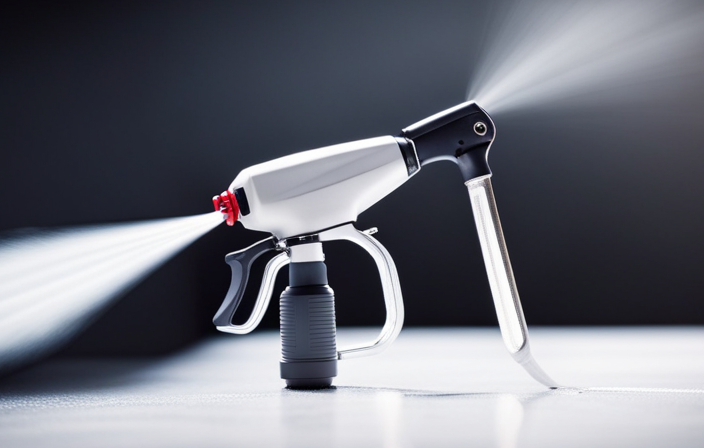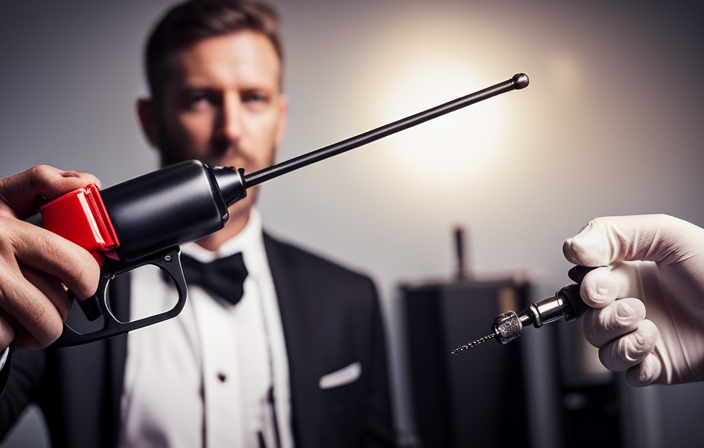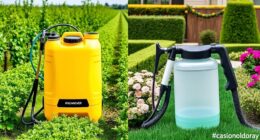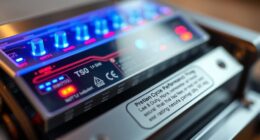When it comes to using an airless sprayer for applying concrete spray, choosing the best paint is crucial. The right paint selection can make all the difference in achieving a flawless finish.
Picture this: a smooth, seamless surface that not only protects your concrete but also enhances its appearance. With the right knowledge and technique, you can transform your concrete surfaces into works of art.
In this article, I will guide you through the process of selecting the perfect paint for your airless sprayer. From understanding the basics of concrete spraying to choosing the right type of paint and applying multiple coats if needed, I’ll provide you with the technical know-how to achieve professional results.
So, let’s dive in and discover the magic of spraying concrete with an airless sprayer!
Key Takeaways
- Avoid over-spraying or under-spraying to achieve even coverage and maximize paint usage
- Apply thin coats and use the proper nozzle size for optimal coverage and adhesion
- Allow sufficient drying and curing time before subjecting the painted surface to heavy traffic or water exposure
- Add a protective sealer to enhance durability and longevity of the paint job on concrete surfaces
Understanding the Basics of Concrete Spraying
To achieve a professional finish when spraying concrete with an airless sprayer, it’s essential to understand the basics of concrete spraying.
Surface preparation techniques play a crucial role in ensuring a successful application. Before spraying, thoroughly clean the surface and remove any dirt, debris, or loose particles. This can be done by pressure washing or using a wire brush.
It’s also vital to repair any cracks or imperfections in the concrete before spraying. Failure to properly prepare the surface can result in poor adhesion and an uneven finish.
Common mistakes in concrete spraying include using the wrong nozzle size, applying the paint too thick or too thin, and not maintaining a consistent spraying distance.
By considering the surface preparation, you can ensure a smooth and professional-looking concrete coating.
Consider the Surface Preparation
Before you begin, make sure the surface is properly prepared for the application. This is crucial for achieving a successful spray concrete finish.
Start by thoroughly cleaning the surface to remove any dirt, dust, or debris that could interfere with the paint’s adhesion. Use a pressure washer or a stiff brush to scrub the concrete surface.
Once the surface is clean, consider the concrete compatibility with the paint. Different paints have different formulations and may require specific primers or additives to adhere properly to concrete. Conduct a compatibility test by applying a small amount of the paint on a small inconspicuous area and check for adhesion.
Taking these steps will ensure that the paint adheres well and provides a long-lasting finish on the concrete surface.
Moving forward, it’s important to choose the right type of paint for spraying concrete with an airless sprayer.
Choose the Right Type of Paint
Selecting the appropriate paint type for your airless sprayer is like finding the perfect partner – it requires careful consideration and compatibility to ensure a flawless finish on your concrete surface. When it comes to spraying concrete, choosing the right type of paint is crucial for achieving optimal results. The type of paint you select will depend on various factors such as the surface condition, desired finish, and the type of spraying equipment you plan to use. For concrete surfaces, it is recommended to use acrylic or epoxy-based paints, as they provide excellent adhesion and durability. These types of paint are specially formulated to withstand the harsh conditions that concrete surfaces often face. Additionally, they can be easily sprayed using an airless sprayer, ensuring a smooth and even application. Now that you have selected the right type of paint, it’s time to move on to the next step – selecting the appropriate finish for your concrete surface.
Select the Appropriate Finish
Now that you’ve found the perfect paint type for your project, it’s time to discover the ideal finish that will truly bring your concrete surface to life. Selecting the appropriate finish is crucial in achieving a smooth and professional-looking result when spraying concrete with an airless sprayer. Here are some key considerations:
-
Selecting the right nozzle: The nozzle size determines the spray pattern and coverage. For a smooth finish, choose a nozzle with a smaller orifice size.
-
Choosing the right pressure: Adjusting the pressure on your airless sprayer is essential for achieving a smooth finish. Start with a lower pressure setting and make gradual adjustments as needed.
-
Applying multiple coats: To enhance the durability and appearance of your concrete surface, consider applying multiple thin coats rather than a single heavy coat.
By following these guidelines, you can ensure a flawless finish that enhances the beauty of your concrete surface.
Now, let’s move on to the next section and discuss how to prep the airless sprayer.
Prep the Airless Sprayer
To prep the airless sprayer:
-
Inspect the sprayer for loose or damaged parts. Tighten or replace as needed.
-
Clean the sprayer to remove any previous paint residue. Flush with water or a suitable cleaning solution.
-
Check the spray tip for good condition and proper alignment.
-
Troubleshoot common issues like clogs or uneven spray patterns.
-
Regularly check and adjust the pressure settings.
By properly prepping your airless sprayer, you’ll be able to tackle the task at hand with confidence and precision.
Transitioning into the next section, it’s now time to practice proper spraying techniques to achieve the best results.
Practice Proper Spraying Techniques
When it comes to spraying concrete with an airless sprayer, practicing proper spraying techniques is crucial. To achieve a professional finish, it’s important to maintain a consistent speed and distance while spraying. This ensures an even application of the paint and prevents any streaks or uneven coverage.
Additionally, overlapping each pass is essential to achieve a uniform and consistent coat of paint. This technique helps to eliminate any potential gaps or missed spots.
Lastly, it’s important to avoid both over-spraying and under-spraying. Over-spraying can lead to excessive paint build-up and drips, while under-spraying can result in thin and patchy coverage.
By following these techniques, you can achieve a high-quality finish when spraying concrete with an airless sprayer.
Maintain Consistent Speed and Distance
To achieve optimal results, it’s crucial to maintain a consistent speed and distance while spraying concrete with an airless sprayer.
When it comes to spraying concrete, having a consistent speed ensures an even application of the paint, preventing any uneven patches or streaks.
Additionally, maintaining the proper distance from the surface is essential for achieving the desired coverage and avoiding excessive overspray. Too close, and the paint may pool or drip, while being too far away can result in thin and inconsistent coverage.
By keeping a steady pace and staying at the recommended distance, you can ensure a smooth and uniform coat of paint on the concrete surface.
Moving on to the next section about ‘overlap each pass for even coverage’, it’s important to ensure a seamless transition between each stroke to achieve a flawless finish.
Overlap Each Pass for Even Coverage
As you glide the sprayer smoothly across the surface, ensure that each stroke seamlessly blends with the previous one, creating a harmonious dance of coverage.
Overlapping each pass is crucial to achieve an even and consistent coat of paint on your concrete surface. By overlapping, you ensure that no areas are missed or left with insufficient coverage.
To achieve the best results, maintain a consistent distance between the sprayer and the surface, typically around 12 to 18 inches. Additionally, pay attention to the speed at which you move the sprayer, keeping it steady and controlled.
If you notice any areas with inconsistent coverage, adjust your technique by overlapping more on subsequent passes. Troubleshooting tip: if you encounter areas with excessive paint build-up, reduce the overlap slightly to avoid over-spraying.
Transitioning to the next section, it is important to avoid both over-spraying or under-spraying to achieve a perfect finish.
Avoid Over-spraying or Under-spraying
Ensure that you don’t waste any precious paint or leave your surface looking patchy by avoiding over-spraying or under-spraying while using the sprayer. Understanding the drying process and troubleshooting common spraying issues are key to achieving a flawless finish. To help you visualize the importance of proper spraying technique, take a look at the table below:
| Over-spraying | Ideal Spraying | Under-spraying |
|---|---|---|
| Wastes paint | Achieves even coverage | Leaves patchy areas |
| Creates drips and runs | Provides a uniform finish | Requires additional coats |
| Longer drying time | Maximizes paint usage | Inadequate protection |
By following these guidelines, you can ensure that each pass with the sprayer is done accurately, preventing over-spraying or under-spraying. Once you have achieved an even coverage, you can confidently proceed to apply multiple coats if needed.
Apply Multiple Coats if Needed
To achieve the best results when spraying concrete with an airless sprayer, it is important to apply thin coats and use the proper nozzle size. This ensures even application and prevents over-spraying or under-spraying. Here are three key points to keep in mind:
-
Apply thin coats: Thick coats can lead to uneven drying and curing, resulting in a less durable and less attractive finish. By applying thin coats, you allow for better adhesion and a more uniform appearance.
-
Use proper nozzle size: Choosing the right nozzle size is crucial for achieving optimal coverage. A nozzle that is too small may result in under-spraying, while a nozzle that is too large can lead to over-spraying. Refer to the manufacturer’s guidelines to determine the correct nozzle size for your specific paint and sprayer.
-
Allow sufficient drying and curing time: After applying each coat, it is essential to allow enough time for the paint to dry and cure properly. This ensures maximum durability and longevity of the finish.
By following these guidelines, you can achieve a beautifully sprayed concrete surface. Now, let’s move on to the next step and discuss the importance of allowing sufficient drying and curing time.
Allow Sufficient Drying and Curing Time
Give your project the time it needs to dry and cure properly, for a finish that will leave you amazed.
When spraying concrete with an airless sprayer, it is crucial to allow sufficient drying and curing time. Concrete paint needs time to dry completely before it can be subjected to any kind of stress or moisture.
The drying time will depend on various factors such as temperature, humidity, and the type of paint used. Generally, it takes around 24 to 48 hours for the paint to dry to the touch. However, it is advisable to wait for at least 7 days before subjecting the painted surface to heavy traffic or exposure to water.
The curing process is equally important as it allows the paint to fully bond and harden. During this time, the paint undergoes chemical reactions that enhance its durability and adhesion.
Once the paint has dried and cured, you can consider adding a protective sealer to further enhance the longevity of the finish.
Consider Adding a Protective Sealer
After allowing sufficient drying and curing time for the concrete, it is important to consider adding a protective sealer. This step can significantly enhance the durability and longevity of the paint job.
One of the benefits of using a primer is that it creates a strong bond between the concrete surface and the paint, ensuring better adhesion and preventing peeling or flaking. Additionally, a primer can help to seal any porous areas on the concrete, resulting in a smoother and more even finish.
When choosing a sealer, it is crucial to select one that is specifically designed for use on concrete surfaces. Factors to consider include the type of sealer (such as acrylic or epoxy), the level of gloss desired, and the intended use of the area. By carefully choosing the right sealer, you can ensure maximum protection and long-lasting results.
Now, let’s move on to how to maintain and clean your airless sprayer.
Maintain and Clean Your Airless Sprayer
To maintain and clean your airless sprayer properly, it is important to follow these steps:
-
Clean your sprayer after each use to prevent paint build-up and clogging. Flush out any remaining paint by running a suitable cleaning solution through the system.
-
Regularly check and clean the filters to avoid blockages and ensure proper paint flow. This will help maintain the efficiency of your sprayer.
-
Inspect and clean the spray tip regularly to remove any debris that may affect the spray pattern. A clean spray tip will ensure a smooth and even application of paint.
-
Troubleshoot common issues such as leaks, low pressure, or uneven spray by thoroughly cleaning and maintaining your sprayer. Often, these problems can be resolved by cleaning the system and ensuring all components are in good working condition.
By following these steps and incorporating regular maintenance and cleaning into your routine, you can ensure that your airless sprayer performs at its best every time.
Frequently Asked Questions
Can I use any type of paint for spraying concrete with an airless sprayer?
I recommend using specific types of paint suitable for concrete surfaces when spraying with an airless sprayer. This method offers numerous benefits, such as even coverage, faster application, and the ability to reach difficult areas.
How long should I allow the paint to dry and cure before walking or placing objects on the concrete surface?
Concrete paint typically takes several hours to dry, but it can take up to 24 hours to fully cure. To speed up the drying process, ensure proper ventilation and use fans. Avoid placing objects or walking on the surface for at least 24 hours.
Is it necessary to add a protective sealer after applying the paint?
It is necessary to add a protective sealer after applying the paint to concrete. This is important because a sealer provides added durability, protection against stains and UV damage, and enhances the overall appearance of the surface. However, using a sealer may increase the cost and maintenance requirements.
What are the common mistakes to avoid when spraying concrete with an airless sprayer?
Spraying concrete with an airless sprayer requires proper technique to avoid common mistakes. One key mistake is applying too much pressure, causing the paint to splatter. Precision and control are essential for a flawless finish.
How often should I clean and maintain my airless sprayer to ensure optimal performance?
To ensure optimal performance of your airless sprayer, regular cleaning and maintenance is essential. Follow these airless sprayer maintenance tips to avoid issues and troubleshoot any problems that may arise.
Conclusion
In conclusion, selecting the best paint for spraying concrete with an airless sprayer requires careful consideration and attention to detail. By understanding the basics of concrete spraying and preparing the surface properly, you can achieve a flawless finish.
Remember to choose the right type of paint and select an appropriate finish to enhance the aesthetic appeal. Don’t forget to prep the airless sprayer and apply multiple coats if needed. Allow sufficient drying and curing time for optimal results.
Lastly, consider adding a protective sealer and maintain and clean your airless sprayer for long-lasting performance. With these steps, your concrete spraying project will be a success!










